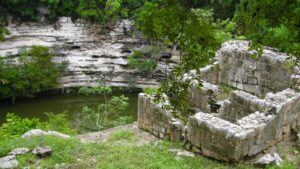
What we see is not always what we expect, whether it is natural or man-made. This is often true with archaeological remains of cities or human settlement, when new discoveries shed unexpected light on old finds, leaving new questions in their wake. Chichén Itzá, the great ancient Maya city in Mexico’s Yucatán Peninsula, is a good case in point. Well-known to thousands of visitors world-wide, it is a place popularly thought to have been thoroughly explored and revealed.
Or so we may think……
At spring and fall equinoxes as it moves from east to west, the sun plays with the angles of the northeast stairway of Chichén Itzá’s Kukulcán pyramid, called El Castillo in Spanish. The course of the sun projects the shadows of the corners of the pyramid onto the vertical northeast face of the stairway balustrade, giving the visual impression of the body of an undulating serpent slowly crawling down toward its stone head at the bottom.
Thousands of tourists gather on the Grand Plaza to witness the event. They come to share in a communal spirit that transcends time and culture. In our time of extraordinary changes in science and technology, unimaginable only twenty years ago, people still search for mythical answers to contradictions and mysteries in a swiftly moving world.
__________________________

The Kukulcan Spring Equinox shadow.
__________________________
The Shadow and the Equinox
For the ancient Maya, the Kukulcán pyramid was representative of the four-sided temple-mountain, or the fourfold partitioning of the world. The name of its deity is a Maya-Yucatec translation from the name Quetzalcoatl in the nahuatl language. It translates as “Quetzal feathered serpent”, whose religious concept came from Tula, in central Mexico. The record shows that the ideology spread throughout Mesoamarica by the Late Maya Classic period (600-950AD).
Kukulcán is believed to represent the Creation Mountain, with its Feathered Serpents’ head and mouth agape at the base of both balustrades of the north stairway. The serpent symbol, in Maya iconography, appears profusely on numerous stone stelae, temple columns and painted ceramics. The shedding of the serpent’s skin was understood as the renewal of time and life through nature’s repeated cycles. This perception explains why the serpent symbol, attached to both life and death events, is so widespread throughout the ancient cultures of the Americas, and beyond.
_________________________
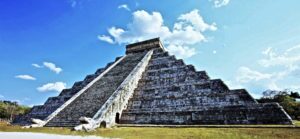
The Temple-Pyramid of Kukulcan
_________________________
The temple-pyramid is not cardinally oriented, although mythologically, it sits at the center of time and space. The pyramid’s corners are lined up on a northeast-southwest axis toward the rising sun at the summer equinox, and its setting point at the winter equinox, making Kukulcán a monumental sun dial for the solar year. Each of the temple-pyramid’s 52 panels contained in its nine terraced levels equal the number of years in the Maya and Toltec agrarian calendars. The nine levels are reminders of the nine steps to Xibalba, the underworld. Above all, Kukulcán is an instrument dedicated to the deities of nature and their role in the repeated night-day alternations, and in life and death.
The main doorway of the outer temple at the top of the pyramid opens to the north. The four stairways ascending the pyramid, one on each side, have 91 steps each, totaling 364 steps that, with the temple at the top, constitute the 365 days of the solar year, the haab’, in Maya. The north stairway is the main sacred path, and it is on its northeast balustrade that the sun casts the triangular shadows. Of note is the fact that, in Maya culture, north equals the departure of the power of nature and anchors the sun in culture. It is a metaphor associated with understanding mankind’s burden and commitment in the universe.
The Great Plaza, Kukulcán and the Primordial Sea
The Great Plaza that surrounds El Castillo on four sides is part of the New Chichén (900-1500AD), a portrayal of the Primordial Sea of Creation from which, according to Maya tradition, all life sprung at the beginning of time. The plaza’s north side, on which Kukulcán is built, was also the area where major ceremonies took place. It is bordered by the Venus Platform, close to that of the Jaguars and Eagle Warriors. Behind it is the massive skull rack, or tzompantli in Nahuatl; it is 164 feet long by 40 feet wide and may be the second largest in Mexico. On the skull rack was a scaffold-like construction of wood poles built over the stone structure, on which hundreds of skulls of war captives and sacrificial victims were displayed anciently.
On the east side of the Great Plaza is the massive Temple of the Warriors, and the no less important Ball Court to the west—the largest in the Americas, it is 552 feet long by 300 feet wide, with walls that rise 20 feet. The Great Plaza was enclosed by a wall over seven feet high, with a limited number of guarded entrances, among which is the one leading to the sacred well, the sacbeh.1 or “white road”; there are over 34 sacbeob (plural for sacbeh), in Chichén. Most buildings are oriented 17 degrees off true north; Kukulcán is 23 degrees off.
_____________________________
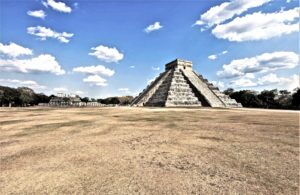
The Great Plaza at Chichén Itzá
_____________________________
Chichén Itza’s Spiritual Gateways
Two other portals, or spiritual gateways, are linked to the temple-pyramid; one natural, the other man-made. The first is the huge sacred cenote, or sink hole, referred to as the “Great Well of the Itza”. This natural well was not used for domestic purposes, but exclusively for rituals. It is reached by the large elevated sacbeh.1, heading 900 feet northward from the Great Plaza and the Venus Platform. The cenote was believed to be the place of communication with the gods of Xibalba, the “Place of Awe”, or underworld, as well as with Cha’ak, the powerful Maya god of rain, lightning and thunder.
The second gateway was the ballcourt where, in accordance with the Maya-Kichè sacred book, the Popol Vuh or Book of Counsel, men and deities of the underworld battle for supremacy, for one or the other team in the real world during ritual ballgames. According to Maya tradition, it is only when ritual games with the deities of the underworld interface simultaneously with a game in the world above that interaction between the two worlds, or field of opposites, was believed to take place. There was no interaction with the deities of the underworld during secular or common games.
The seasons and the metronomic passage of heavenly bodies were understood by the Maya as essential markers to alleviate anxieties of daily life by their repeated familiarity. Their transit through both day and night is enshrined in belief structures and ceremonies spanning thousands of generations. After all, the Maya believed that the sun did not set, but continued its course as the “black sun” at night, to gloriously rise again the following morning. Most ancient monuments are also associated with this spiritual view of the world, essential to carrying out the secular and spiritual functions of cultures.
The Cenote of Sacrifice, the First Gateway
The sacred well is oval shaped (164 feet by 200 feet). From its lip to the water the drop is 72 feet and its depth is 65 feet; there is a bed of mud about 20 feet thick at the bottom.
_________________________
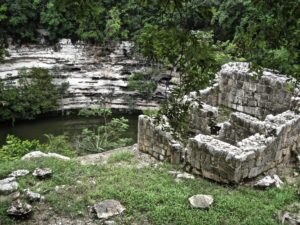
The Well of Sacrifice
_________________________
In one of the rooms of the structure built on the lip of the Well of Sacrifice was the temazcal, or steam bath, to purify sacrificial victims to Cha’ak, god of rain and thunder, and its deities. Gifts were of precious jade and gold, fine ceramics—and human lives—as human remains found at its bottom testify. Noteworthy is the absence of Toltec material in the cenote. Each offering was made in accordance with the needs of the time and the demands of the gods. The archaeological record shows that human sacrifices were of both gender and of any age. In time of dire needs such as a persistent drought, a community would sacrifice its best, not the sickly or the maimed. Sacrificed victims had to be able and in their prime and, the younger the better, for Cha’ak would not accept anything less.
Fundamentals in Maya Belief Structure
The socio-economic organization of ancient Maya communities was based on agriculture, grounded in two seasons at that latitude, which meant two harvests. Hence the Maya belief structure and religious organization that adhered to their seasonal and daily partnership with nature. The gods and deities from their pantheon were those driving the fundamentals of nature they knew: the sun, rain and the vegetable world.
These fundamentals are enshrined in the Popol Vuh, which describes the creation of the universe by the gods who, after failing four times, succeeded in creating mankind out of maize dough. Above all, concurrently with the deities, ancestors were believed to participate at every stage of family daily life and, for this reason, were prominent recipients in self-sacrifice ceremonies.
The serpent sculpted on monuments at Chichén Itzá and other ancient Mesoamerican and Mexican sites is a metaphor. It was perceived that its body as it moves is comparable to the swirls of smoke after a self-sacrifice by members of the nobility or the priesthood, when a person’s blood falls on bark paper that is then burned. The swirling smoke was then believed to carry the prayers of the supplicant to ancestors and deities, seeking their guidance for living another day in a dangerous world. In ceremonies today, copal nodules, known as pom in Maya-Kichè, are used instead of human blood. Copal, copalli in Nahuatl, is a resin obtained from the sap of tropical trees, believed to be the equivalent of the “blood” for the vegetal world.
Planting and harvesting were therefore essential daily concerns, together with the weather—rain specifically—because its delay or limited downpour could translate into a bad crop, or no crop at all, and its consequences: famine, death, and the return of anguish and fear. The milpero’s (farmer’s) profound mystical relationship to corn’s mythological substance, and not just its use for actual sustenance, to this day results in a way of life entirely alien to non-traditional communities.
The Great Ball Court, the Second Gateway
The second portal at Chichén is the man-made spiritual gateway, the Great Ball Court, located on the west side of the Plaza together with the Temple of the Jaguars. For the ancient Maya, ball courts, through specific ritual games, were believed to open into the “other world.” This “opening”, however, could only take place during a ritual fateful game destined to end in sacrifice. The deities of Xibalba, the underworld, did not play unless a ritual contest took place above ground at the same time. It is only when the ritual games were concurrent in this world and the “other” that the interplay between the participants in the two worlds were believed to materialize. The metaphor that took place in the ballcourt reflected the tribulations of life and death that define human struggle and tragedy.
Through history the universal use of games for secular and ritual reasons underlines the same need for maintaining peace and balance within communities. Essential to ritual games, and to a certain extent secular games as well, was the need to keep in check latent antagonism between factions of the same polity, as well as between polities.
_________________________
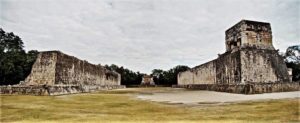
The Great Ball Court
_________________________
The concept of Kukulcán, or “Feathered Serpent,” dates to the Maya Late Classic Period (600-900AD), when the serpent was known as waxaklahun ubah’kan. In Guatemala the deity was called Guqumatz by the Maya-Kichè, but was an evil monstrous snake, the pet of the sun god, with the Maya-Lacandón. Kukulcán is also the Maya name for the god of agriculture, wind, and storms. He also appears in Postclassic period (900-1500AD), as the Vision Serpent. The god came in the early 7th century with the Toltecs that migrated from Tula. The record shows a long history with Teotihuacán and Tula, on the central plateau of Mexico.
The Maya were already trading with cities of central Mexico with the concurrent exchange of technologies and beliefs inherent with such contacts. Toltec groups migrated sporadically to the Yucatán throughout the 6th century and possibly earlier. Together with Maya-Chontal, called the Itzá that came from Ppolè on the Yucatán’s south coast, they united their forces at Cobá, about 62 miles on the connecting sacbeh to Yaxuná, and 13 miles from Chichén, with those of the Toltecs. From there, they conquered Chichén Itzá in 987. This event is recorded as “the great descent.”
The Mexicans introduced human sacrifice on a scale unknown before by the Maya. Their military expansion aimed at dominating the surrounding land and people, together with control of the important salt trade and sea routes around the peninsula. Their main anchor on Isla Cerito gave them and their allies command of the Yucatán coastal trade routes. Meanwhile in the countryside Maya gods and deities remained mostly unchanged, since the cult of Toltec deities centered in large towns and cities.
The First Pyramid and the Cenote Within
Chichén Itzá today is not the city that was conceptualized by the Maya before the arrival of the Toltec-Itzá invaders. Long before it was called Uuc Yab’nal (the city’s name in Maya-Yucatec). In the early 1950s investigations brought to light a smaller pyramid of nine terraced levels within Kukulcán. Building a larger structure over a smaller one was common practice in the Maya and other Mesoamerican cultures. The was because the first structure was believed to be saturated with ancestor power that could not be denied through destruction or return to nature through demolition or decay, under pain of failure of the new generation and its ultimate demise.
The single stairway of the buried temple faces northwest; it has 61 steps and a temple on top with two parallel galleries. There is a triple molding on its façade and a frieze showing a parade of jaguars, shields and two intertwined serpents over the entrance. The similarities between the two pyramids indicate that the one within may also be of Toltec origin.
In the antechamber of the inner temple archaeologists found a red jaguar that may have served as a throne for the High Priest. On the seat was an offering of a turquoise mosaic disk. The jaguar is painted red on limestone; the teeth are made of flint, and there are incrustations of fine jade disks for its eyes and on its body, for the animal’s spots.
________________________
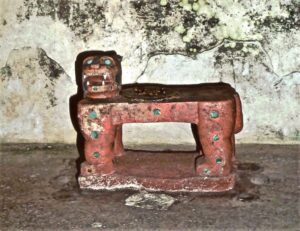
The Red Jaguar Throne. HJPD, Wikimedia Commons: Photo created in
1970; Attribution-ShareAlike 3.0 Unported (CC BY-SA).
________________________
In 1958 a cenote and a cave were found 50 feet below the pyramids; the discovery was sealed off from the outside world, probably for lack of resources for further exploration at the time. The cenote and the cave system were “re-discovered” during the ongoing research program of the “Great Maya Aquifer”, and “Chichén Itzá Underground” research programs, approved in 2016. The 1500-foot long cave is called Balamkú, or “God Jaguar” in Maya, but its ancient name is unknown. The jaguar is a central figure in Mesoamerican and other mythologies of the Americas because of the belief in the animal’s ability to enter and leave the underworld at will.
Balamkú remained sealed for more than 50 years after its discovery; it was reopened in 2018 by National Geographic’s Explorer Guillermo de Anda and his team of investigators from the Great Maya Aquifer Project (GAM), during their search for the extent of the water table beneath Chichén Itzá. Exploration of the system was funded in part by a grant from the National Geographic Society, and in cooperation with the University of California at Los Angeles.
Thus far, over 170 ceramic bi-conical censers were found in seven small rooms carved from the limestone, identified as those of the Toltec god Tlaloc. The ceramics are dated from the Late Classic (700-800AD) to the Terminal Classic (800-1000AD). This important discovery will no doubt help rewrite Chichén Itzá’s history.
_______________________
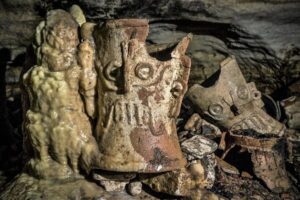
Tlaloc Bi-Conical Censers
_______________________
INAH-GAM archaeologist Guillermo de Anda suggests that Balamkú appears to be the “mother” of Balankanchè cave, 1.5 miles away. “I don’t want to say that quantity is more important than information,” he states, “but when you see that there are many, many offerings in a cave that is also much more difficult to access, this tells us something.” Archaeologists now have the opportunity to answer some of the most perplexing questions that continue to stir controversy among mayanists, such as the level of contacts and influence exchanged between different Mesoamerican cultures, and what was going on in the Maya world prior to the fall of Chichén Itzá.
Chichén Yet to be Discovered
Then as today, traditions were comparable to those seen on more recent temple-pyramids, which symbolically show the same concern for life’s daily predicaments, and societies’ dependence on agriculture. Was the serpent’s shadow also seen on equinoxes on the now-hidden pyramid within Kukulcán? We do not know. The sun’s shadow, as seen on the more recent structure may not have been visible then, given its smaller size and angle of the buried structure.
There will be much more to be said about Chichén Itzá, since much is still hidden, as work on the Balamkú cave has attested. Furthermore, excavation programs in the Great Plaza, initiated in 2009, revealed buried structures that pre-date Kukulcán. By 2009 we already knew about the pyramid within. Puzzling discoveries and wonders are certain to continue. Mysteries remain: What else does Chichén Itzá, and its great pyramid hold? What happened to Kukulcán after the defeat of Chichen Itza by Unac Ceel, ruler of Mayapan in the 13th century? The deity moved with the conqueror to the new Maya political epicenter, 65 miles to the west; but that is another story.
_________________________
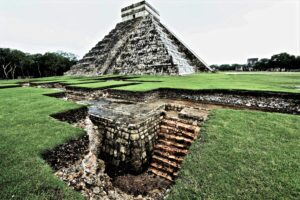
Great Plaza Discoveries
_________________________
This narrative is only a glimpse of the ancient city’s complex history. Understanding the questions about its great past will take more “stories” and, no doubt, new interpretations in light of ongoing discoveries. As well, other major monuments of the ancient city can be presented together with their history and purpose, from Old Chichén, to the Observatory (or Caracol), the Temple of the Warriors, Temple of the Three Lintels, the common well Xtoloc or “iguana”, the Chinchán-Chob or Red House, the Osario and its cenote below, and the Nunnery that together with the Akab-Dzib, are among the oldest buildings, and much more.
Stay tuned for more to come.
__________________________
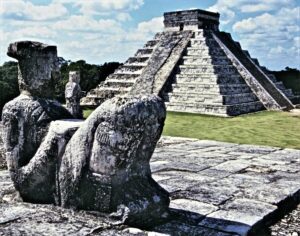
__________________________




